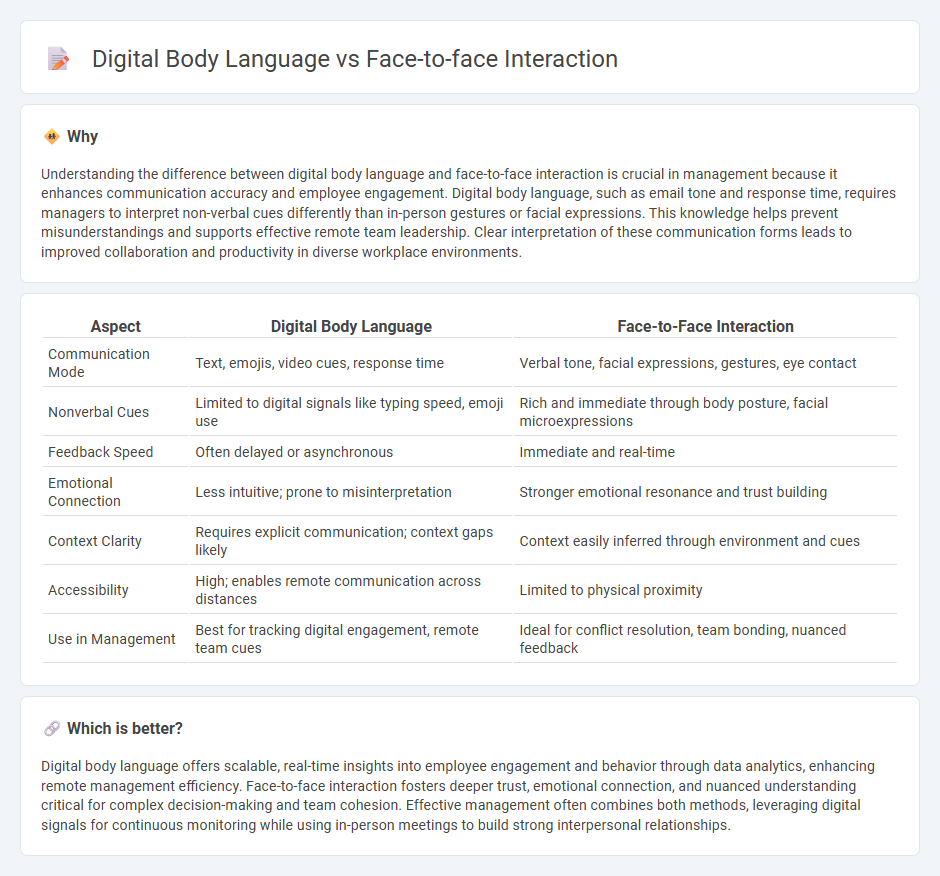
Digital body language encompasses the subtle cues and behavioral signals conveyed through online communication platforms, influencing team dynamics and decision-making in remote work environments. Face-to-face interaction allows for immediate, nuanced feedback through verbal and non-verbal expressions, fostering stronger interpersonal connections and trust. Discover how mastering both forms of communication can enhance leadership effectiveness and organizational success.
Why it is important
Understanding the difference between digital body language and face-to-face interaction is crucial in management because it enhances communication accuracy and employee engagement. Digital body language, such as email tone and response time, requires managers to interpret non-verbal cues differently than in-person gestures or facial expressions. This knowledge helps prevent misunderstandings and supports effective remote team leadership. Clear interpretation of these communication forms leads to improved collaboration and productivity in diverse workplace environments.
Comparison Table
| Aspect | Digital Body Language | Face-to-Face Interaction |
|---|---|---|
| Communication Mode | Text, emojis, video cues, response time | Verbal tone, facial expressions, gestures, eye contact |
| Nonverbal Cues | Limited to digital signals like typing speed, emoji use | Rich and immediate through body posture, facial microexpressions |
| Feedback Speed | Often delayed or asynchronous | Immediate and real-time |
| Emotional Connection | Less intuitive; prone to misinterpretation | Stronger emotional resonance and trust building |
| Context Clarity | Requires explicit communication; context gaps likely | Context easily inferred through environment and cues |
| Accessibility | High; enables remote communication across distances | Limited to physical proximity |
| Use in Management | Best for tracking digital engagement, remote team cues | Ideal for conflict resolution, team bonding, nuanced feedback |
Which is better?
Digital body language offers scalable, real-time insights into employee engagement and behavior through data analytics, enhancing remote management efficiency. Face-to-face interaction fosters deeper trust, emotional connection, and nuanced understanding critical for complex decision-making and team cohesion. Effective management often combines both methods, leveraging digital signals for continuous monitoring while using in-person meetings to build strong interpersonal relationships.
Connection
Digital body language complements face-to-face interaction by providing insights through online communication cues such as response time, message tone, and emoji use. Understanding these digital signals enhances a manager's ability to interpret emotions and engagement levels in remote teams, fostering stronger connections despite physical distance. Integrating digital body language analysis with in-person observations improves overall communication effectiveness and team management.
Key Terms
Nonverbal Communication
Nonverbal communication in face-to-face interactions relies heavily on gestures, facial expressions, eye contact, and body posture to convey emotions and intentions, offering immediate feedback and richer context. Digital body language, including emoji usage, typing speed, and message tone in chat or video calls, compensates for the absence of physical cues but often requires interpretation and can lead to misunderstandings. Explore how mastering both forms enhances communication effectiveness across diverse platforms.
Emotional Intelligence
Face-to-face interaction allows for the rich exchange of nonverbal cues such as facial expressions, eye contact, and gestures, which are essential components of Emotional Intelligence for accurately perceiving and responding to others' emotions. Digital body language, including emoji use, typing speed, and message tone, offers new challenges and opportunities for emotional understanding in virtual communication. Explore how mastering both forms enhances interpersonal relationships across diverse settings.
Engagement
Face-to-face interaction fosters richer engagement through immediate verbal and non-verbal cues, such as eye contact, facial expressions, and body posture, which digital platforms often struggle to replicate accurately. Digital body language includes emoji use, typing patterns, and response timing, offering new ways to interpret engagement but lacking the depth of in-person signals. Explore how mastering both forms enhances communication effectiveness in hybrid work and social environments.
Source and External Links
Face-to-Face Communication: 6 Benefits of Leading in Person - Discusses the importance of face-to-face communication in leadership, highlighting its ability to convey deeper meaning through tone, voice inflection, emotion, and body language.
What is face-to-face communication and why is it important? - Explains face-to-face communication as a method that includes both verbal and non-verbal elements, enhancing interaction through body language and tone of voice.
The power of face to face communication - Highlights benefits such as fewer misunderstandings, greater effectiveness, and stronger bonds, emphasizing the role of emotions in persuasion.
 dowidth.com
dowidth.com